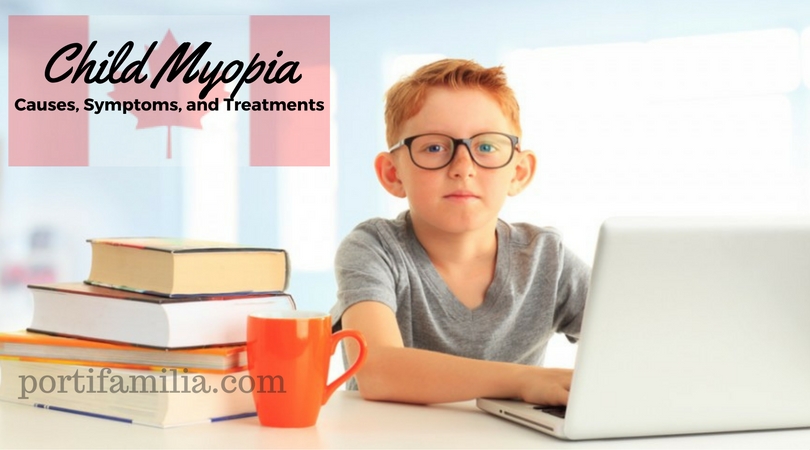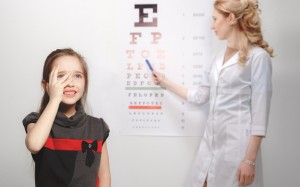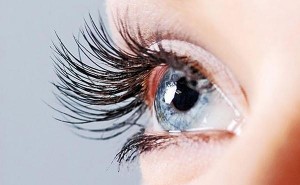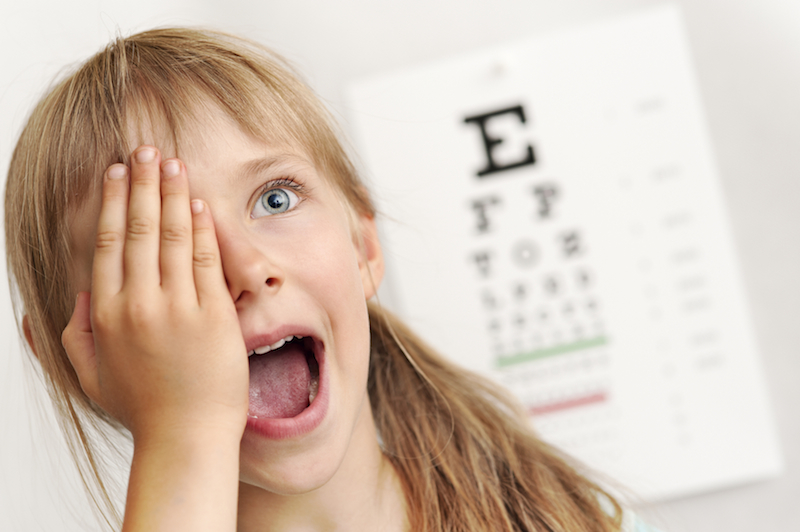One third of the world’s population suffer from different forms of myopia. In East Asian countries 80% of people over the age of 18 have symptoms of myopia. In the United States the spread of the disease has increased from 25% to 42% over the past 30 years. According to the research of Canadian Family Pharmacy, the number of students with myopia increases during school period from 12% to 55%. Progressive myopia (when the eye grows in length) is noticed between the ages of 6 to 17 years old, sometimes – from 5 to 21. There are many effective treatments for children’s myopia, so it is important to slow down and stop the disease precisely in the period of active growth of the body. Parents need to make sure that the weak myopia of a child doesn’t turn into severe myopia, which is one of the factors of disability on sight.
Myopia types
- Short sight, or myopia, can be congenital, that means, children may be born with myopia. If someone in the family suffers from myopia, the baby is also prone to the emergence of the disease.
- The illness can manifest itself at any time, but most often it happens in the period of schooling. During this period, healthy children may experience false myopia. It can turn into a true myopia if preventive and curative measures are neglected.
Child myopia may be suspected when a child can not see distant objects properly. Often kids are unaware of their disease. They just do not understand what they have incorrect vision.
Myopia symptoms can often be noticed only at school when a child has difficulties with reading from the chalkboard:
- The child comes close to the TV screen;
- screwing up his eyes;
- complains of headache, eye strain, eye fatigue;
- the child has to focus on objects located further from his eyes than a meter.
The visual system of children is developing till he is eight years old. In this period it is especially important to identify violations of refraction:
- nearsightedness;
- farsightedness;
- astigmatism.
If they are not corrected with the help of eyeglasses, they can lead to such disorders as amblyopia (“lazy eye”). Regular surveys of preschool children help detect potential problems in the early age.
If a child is diagnosed with reduced vision during such examinations, they conduct further tests to identify the error of refraction.
Who is in a risk group?
Most ophthalmologists believe that the risk of child and adolescent myopia depends on the amount and severity of factors: the more factors – the worse prognosis. Parents should know what may cause progressive children myopia to prevent the disease. Let’s consider the major factors.
- Age. The earlier age of child suffering from myopia, the more progress the disease will have. Early acquired myopia among children of preschool age has the most pessimistic forecast in relation of eye-sight.
- Sex. Girls suffer from myopia more often – in the ratio of 55/45. They have a more progressive disease.
- Heredity. If a family has one or both parents who suffer from myopia, their children is likely to have congenital myopia: the probability of the disease is 3-6 times higher than in the absence of aggravating factors.
- Lifestyle. A disease progresses 3 times faster if children lead a sedentary lifestyle and are not involved in any sports. A balanced diet with the right amount of protein and carbohydrates, essential vitamins, macro and micro elements is very important. Since childhood, parents should pay attention to the correct position of a child while reading and writing, monitor the lighting of the room, avoid long visual loads in front of the TV and the computer.
- Co-diseases. For example, birth or acquired spinal or brain traumas, prematurity, acute and chronic diseases may provoke myopia development. Myopia also may be caused by anatomical features of the eye structure: the weakened accommodation, congenital astigmatism, anisometropia.
Causes of children’s myopia
 The cause of children’s myopia is the increase of the eye length. This process can be triggered by such factors:
The cause of children’s myopia is the increase of the eye length. This process can be triggered by such factors:
- hereditary factors;
- overwork;
- continuous long-term operation at the close distance;
- lack of hygiene;
- general weakening of the body.
Infants’ nearsightedness
Most often, children from 7 to 13 suffer from myopia. However, in some cases, this abnormality can be diagnosed in infants. We speak of a congenital myopia. Premature babies and children, whose family has short-sighted members, are especially prone to this disease development.
These kids require particular myopia control – they should visit an optometrist in the first months of their life. The specialist conducts clinical refraction in the cycloplegic conditions.
As a rule, a congenital myopia is stable. However, it is necessary to identify and correct the disease by means of glasses as soon as possible. This will enable the visual analyzer to develop properly.
Myopia in children of school age
 Nearsightedness (myopia) is the most common violation of schoolchildren. Only 3% of first-graders have this pathology, but the number is already 25% by the end of the school.
Nearsightedness (myopia) is the most common violation of schoolchildren. Only 3% of first-graders have this pathology, but the number is already 25% by the end of the school.
Such an increase in the number of short-sighted among school-aged children is associated with increased visual load during schooling (students spend many hours per day reading and writing in textbooks and exercise books). Both – children predisposed to myopia due to heredity and healthy children may sufer from short sight.
Healthy children may acquire false myopia in connection with a significant load.
False children’s myopia
- Students are screening the books and notebooks for hours. In addition, they often take a wrong body position, violating the sight hygiene: keep the book close to the eyes, ignore the correct lighting mode.
- Eye fatigue causes a spasm of accommodation. This is a long-term and stable state of the ciliary muscles, when the latter can not relax at the look transfer to distant objects, making them blur. Spasm of accommodation is also called false myopia (pseudomyopia).
- Spasm of accommodation should be removed by means of medication. In addition, it is necessary to reduce the visual load and do exercises for the eyes.
Myopia and quality of life
 In recent years, experts note a disturbing trend of increasing myopia in schoolchildren with co-diseases, which threaten the total or partial loss of a visual function. However, you should remember that even the first stage of myopia can significantly reduce quality of life.
In recent years, experts note a disturbing trend of increasing myopia in schoolchildren with co-diseases, which threaten the total or partial loss of a visual function. However, you should remember that even the first stage of myopia can significantly reduce quality of life.
- Limitation of active lifestyle. Children of any degrees of myopia are contraindicated sports requiring significant physical exertion, vibration, body tremors;
- The impact on the choice of profession. And perhaps, the fate of man. A child with myopia will probably have to refuse a dream of a designer, pilot or sailor career. In general, many modern professions are related to the work at the computer, but not all people suffering from nearsightedness can bear this load;
- The need for constant optical correction. Often nearsightedness is bilateral, and even a weak degree of the disease is irreversible. That is why, both adults and children have to wear glasses or lenses – this requires adaptation, including psychological.
Know the enemy
Modern myopia is characterized by an intermittent flow.
- The first peak is observed at the age of 8,
- adolescents face the disease at age of 13,
- then -17,
- later – at the age of 23.
The cause of children’s myopia in these periods is associated with increased eye strain at the start of school, with the active growth of the organism, with a college, and then with working.
However, parents often do not notice the child’s myopia. The child does not understand or pays no attention to the fact that his eyesight deteriorates, and adults ignore regular clinical examination, during which the disease can be timely identified.
The first signs of child myopia:
- squinting;
- stretching the eye outer corner;
- watching television at the close distance;
- low inclination of the head;
- the child’s success at school may reduce as a result of bad vision of notes on the blackboard.
It is important to quickly identify children’s nearsightedness – during the first 4-6 months. In this case, doctors diagnose “pseudomyopia”. This child’s myopia may be eliminated in 20-25% of cases. If you do not take action in time, the false myopia will grow into a true (axial) form throughout the year.
How to cure myopia: Eye vitamins
 Do we need to treat “school myopia”? Many people ask such question. It is known that the true short-sightedness (myopia or weak high) can’t be cured, as the eye has stretched out, the focus of a clear vision moved away from the retina, and the distance eye sight deteriorated. Is it worth making efforts and spending time? Yes, it is. The child myopia treatment slows down its progression, promotes stabilization, reduces the risk of possible complications.
Do we need to treat “school myopia”? Many people ask such question. It is known that the true short-sightedness (myopia or weak high) can’t be cured, as the eye has stretched out, the focus of a clear vision moved away from the retina, and the distance eye sight deteriorated. Is it worth making efforts and spending time? Yes, it is. The child myopia treatment slows down its progression, promotes stabilization, reduces the risk of possible complications.
School children myopia may be relieved, but on the condition of a proper complex treatment:
- optical correction;
- drug therapy (special eye drops to train the ciliary muscle, eye vitamins);
- functional hardware therapy.
You may buy eye vitamins and eye drops online at Canadian Family Pharmacy: Lumigan, Xalatan, Patanol, Acular.
How can we stop myopia?
We may stop the disease no earlier than 1-2 years after the treatment beginning. Besides, it is necessary to strictly follow the doctor’s advice (the restriction of the visual load, gymnastics for the eye, sport, a balanced diet with the required amount of vitamins). The hardest myopia to be stopped is myopia under the age of 6-8. This form of the disease is characterized by intermittent flow, when we may observe deterioration after the stable period. In this case, the child myopia treatment should be carried out through the courses of 4-6 months during the progression of myopia.
It’s not that easy to change the child’s lifestyle and motivate him for these changes. But the only way to overcome myopia is an obstacle that people create on the road of their life.
Preventive measures. How to reduce myopia naturally?
- Vitamins and minerals. The content of vitamins A, C and E, B group influence vision. Thus, the child should have a balanced nutritious diet rich in vitamins and minerals. Vitamins for eye health can also be useful for myopia prevention. Full list of essential eye vitamins you see in the catalog of Canadian Family Pharmacy;
- Exclusion of emotional overload. During emotional stresses eye muscles remain tense even in the absence of visual work. TheThis may result in a vasospasm, blood circulation worsening, reduced visual acuity;
- Preventive exercises for the eyes. Special exercises help strengthen the eye muscles. Exercises should be done regularly: 2-3 times per day;
- Correct habits. It’s necessary to alternate visual work and active games, have well-chosen furniture, good lighting, TV watching and computer work limitation, full sound sleep;
- The active lifestyle and sports. It is proved that myopia is more common for adolescents and children with poor physical development. Systematic walking outdoors and sports – swimming, skating, skiing may help prevent the disease. Games with a moving subject – badminton, tennis, volleyball, football – also have beneficial influence on the visual function. But the lessons associated with excessive loads, such as boxing, wrestling, any jumping, ice hockey and powertlifting are contraindicated in case of problems with eyesight;
- Regular visits to a ophthalmologist. Timely disease identification can help prevent the development of myopia and return a normal vision to the child. Therefore, eye doctors recommend regular checkups every 6 months.

